Arbiters’ Manual 2022 released
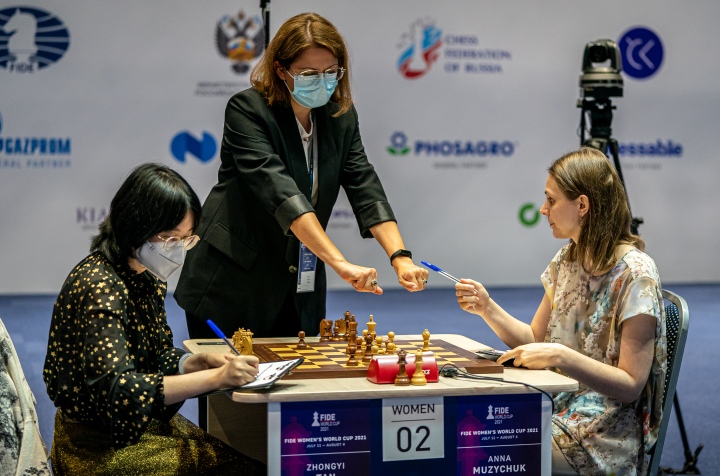
Last week, the FIDE Arbiters’ Commission released the edition 2022 of the FIDE Arbiters’ Manual. This new edition includes some important changes in regulations that every arbiter should be familiar with. It would also be highly recommended that players read this document – as well as, of course, the laws of chess. Chapter 10 is now called FIDE Regulations for arbiters, with new regulations on titles, training, classification and selection of arbiters in FIDE World Events. Chapters 6 and 7 reflect the recent changes in the regulations for ratings and titles. They are critical for our colleagues delivering player norms. The Arbiters’ commission also reviewed the exam questions and have updated them accordingly, preventing discrepancies between the official text and the concrete examples presented. The International Arbiter Shohreh Bayat, Councillor of the ARB Commission, was the leader of the project. On her behalf, and on behalf of FIDE, we would also like to thank all those who contributed with their time and their inputs. In particular, Alex McFarlane, Gopakumar Sudhakaran, Juergen Klueners, Aris Marghetis, David Sedgwick, Jens Wolter, and Alex Holowczak. Arbiters’ Manual 2022 (pdf)
FIDE Grand Prix Berlin final: Aronian vs Nakamura
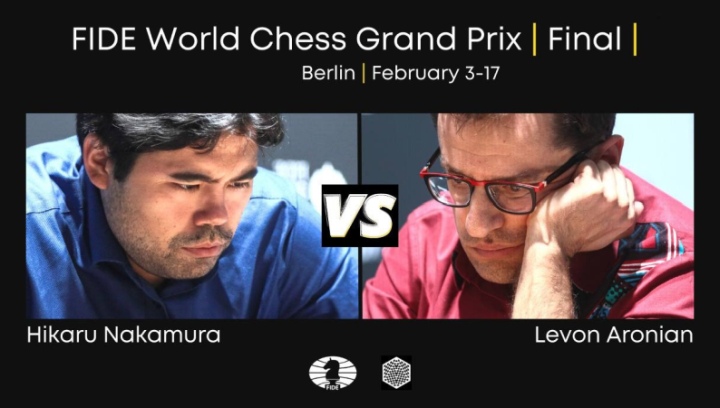
IM Michael Rahal – Berlin, February 12th – Levon Aronian and Hikaru Nakamura, both playing with Black, scored safe draws in their games today against Leinier Dominguez and Richard Rapport and advanced to the final of the 2022 FIDE Grand Prix Berlin. In his game against Dominguez, Aronian decided to play very solidly, developing his bishop on e7 instead of his usual Bc5. Although Dominguez got a small edge from the opening, it was clearly not much. Once again better prepared, Aronian was blitzing out his moves while Dominguez was finding it hard to hang on to any kind of initiative. The game fizzled out to a rook ending with three pawns apiece, and a draw agreed on move 31. Aronian’s preparation for this line was excellent. In conversation with Press Office Michael Rahal, he said: “I have analysed this position a bit from White and Black, of course. It’s slightly worse for Black, he keeps a small advantage and presses, but it’s a solid type of position. If White doesn’t play the most precise moves, it gets into a drawish type of position. I thought that playing solidly would be a good idea in a game in which I needed a draw”. Leinier was definitely not expecting this line today: “I was slightly surprised by Levon’s opening choice as he normally plays Bc5. I was hoping to get some pressure, but after b4, which looks natural, it gets very concrete, and I am not even better. It’s a bit sad for a must-win situation, as I am not even close. Black is doing very well here; I couldn’t do much more”. When questioned about his excellent result here and his focus on the Candidates spot, Aronian dodged the issue: “Generally, I just want to work on my chess and improve as a player, and continue doing what I love. It’s not directed especially towards a goal. Of course, some of the work I did pays off, but this is an ongoing process in which you work but try not to think of what you are working for”. Although eliminated, Dominguez was pleased with his result: “The result is objectively not bad at all as I keep decent chances for the last event. I think that I have to work more on my physical shape: my level tends to drop a bit towards the end of the tournament. I get a bit tired, especially when you have tense games, which is the case in these top events”. You can watch a postgame interview with both players on the World Chess Youtube channel The second semifinal game was certainly more exciting. With White, Rapport opened with the King’s Indian Attack, which he had employed a couple of years ago in a Bundesliga game. Nakamura reacted in a principled manner, occupying the center and establishing strong outposts for his knights on e4 and c4. Even though most of the pieces were still on the board, Rapport couldn’t find the way to get things going and soon had to adopt a passive approach. Sensing that the initiative was on his side, Nakamura offered a draw on move 30, which Rapport accepted. “I was happy with the outcome of the opening, but I should have probably traded on e5 some pieces. I tried to do something smarter that didn’t work out” was Rapport’s first impression after the game. Nakamura was surprised by Rapport’s opening choice: “I wasn’t expecting it. I vaguely looked at this Nc6 idea recently. My opponent in the final, Levon has actually played this a few times, so it was certainly familiar. But with my knight on e4 supported by my pawn on d5 his bishop on g2 is never active but the match situation – Rapport forced to play for a win – didn’t allow for much more”. “I could have played on, but who wants to waste time. Who cares about rating points? Winning the match was the only important thing”, was Nakamura’s point of view when he was asked about continuing in the final position. Speaking of his tournament performance, Rapport was very critical:” I think I played very poorly here, and I was very fortunate to qualify from the group stage. Also, I came here from playing Wijk aan Zee, an extremely long event, and here I played long games and ran out of stamina. I will play the next event in Belgrade, which is actually like home turf for me as I have been living there for a while”. As there are no tiebreaks, the players will enjoy a free day tomorrow. The first game of the final will be played on Tuesday, February 15th. Hikaru Nakamura will have white pieces. You can watch a postgame interview with both players on the World Chess Youtube channel About the Tournament The three-tournament Grand Prix series, which will unfold from February to April, features twenty-four of the world’s best Grandmasters, who will compete in two of the three events. In order to make the series more exciting and reduce the percentage of draws, FIDE and World Chess have changed the format. This innovative approach is new for the chess world but very similar to the Super League: the first stage has four pools of four players, and the winner of each pool advances to the semifinals and then to the final. The venue of the first leg is the World Chess Club Berlin, located at the City Centre on Unter den Linden, 26-30, and the games will be played from February 4th-17th every afternoon at 3 pm. Along with the two qualification spots for the Candidates, the event has a 150.000 euros prize fund, 20.000 euros more than the 2019 series. All the games will be broadcasted live with expert commentary in three languages at https://chessarena.com/broadcasts/13604 More information and the full schedule can also be found on the worldchess.com website. Full pairings can be found here. Due to COVID restrictions currently in place, only a limited number of tickets are available. Please note that the 2G+ rule applies to the event, which
FIDE Grand Prix: Aronian and Nakamura pull ahead
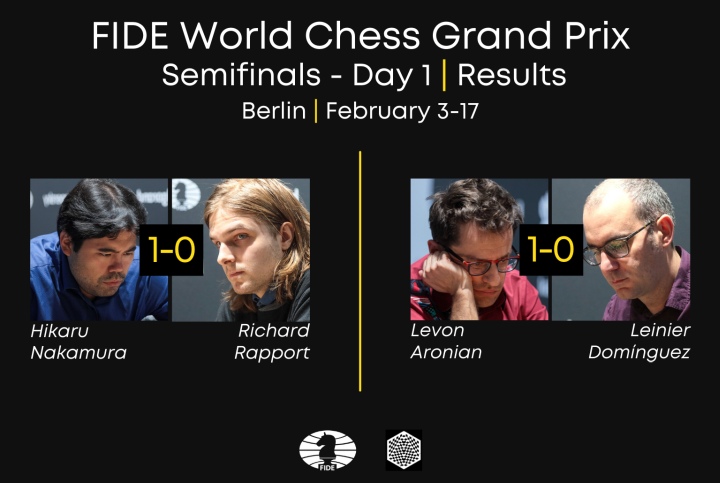
Rapport and Dominguez Perez must win on-demand tomorrow IM Michael Rahal – Berlin, February 12th 2022 – The semifinals began punctually with the ceremonial first move made by German cabaret artist Matthias Deutschmann on board one. After the customary greetings, Nakamura indicated his intention of opening the game with 1.d4 and Deutschmann firmly moved the d-pawn two steps forward. The rules and regulations of the 2022 FIDE Grand Prix determine a €24,000 prize for the winner while the runner-up receives €18,000. Both semifinalists receive checks for €12,000. In addition to the prize money, the winner of the Berlin leg gets 13 Grand Prix points, quite a few more than the 7 received by the semifinalists. Winning here – or at least advancing to the final – is definitely a huge step towards the final goal: the two spots that qualify to the Candidates. The USA Olympic teammates Levon Aronian and Leinier Dominguez Perez have played at the highest level for more than fifteen years. According to the database, their first encounter was played in Beersheba (Israel) in the 2005 World Team Championship, in the match between Cuba and Armenia. That game ended in a relatively quick draw and, since then, they have faced each other 59 times, excluding online events, with a clear advantage on the scoreboard for the former Armenian player: 37½ – 22½. However, if we factor out the OTB rapid and blitz games, Aronian barely leads by 4-3. Having won his preliminary group with a round to spare, Aronian has essentially enjoyed two rest days, while Dominguez returned to the playing venue yesterday to eliminate Wesley So. But these things can work both ways – you can never know if extra games and effort favours a player or makes him even more tired. Although, according to rating Richard Rapport would be considered a favourite, things are not so clear if we go over their head-to-head record. Excluding blitz and rapid events, Nakamura has scored 2½ points in the 3 games where they have played. Also, the American qualified to the semifinals with no need of a tiebreak, which means one extra rest and preparation day for him. Finally, every classical game of this tournament has an added importance for Nakamura: he has already confirmed here that he will only play for the USA in the Moscow Olympiad if he is one of the four main boards, never as a reserve. Currently, he is in fifth place behind Caruana (2792), So (2772), Aronian (2772) and Dominguez (2752), so he still has some ground to cover. Board 1: GM Hikaru Nakamura (USA 2736) – GM Richard Rapport Hungary (2779) Rapport went for the Queen’s Gambit declined in this very important game. In the opening, Nakamura kept looking at the games monitor and checking out the other board: obviously, he was also interested in Aronian’s choice in a sharp line. For many moves, the position was identical to Kasparov-Smyslov from the 1988 USSR Chess Championship, until Nakamura diverged with 15.Kb1 (15.Nf4 was played in that game and a draw was agreed son after). Rapport kept the balance with precise defensive moves until Nakamura initiated some interesting tactics on the kingside with 23.Bxg6!?, giving up the exchange but securing an outside h-passer. Low on time, Rapport couldn’t find the best defence, and soon he decided to return the material. However, although only a pawn down, the rook ending was very difficult to defend for Black due to Nakamura’s active king and passed center pawns: with a few accurate moves, Hikaru wrapped up the game. In conversation with IM Michael Rahal, Press Officer for the event, Nakamura felt that he had played well, but complicated things unnecessarily: “Of course, it should be winning, but it’s very tricky: with one bad move and I can lose, Black has two pawns as well, going down the a and b files. I was quite mad at myself because at the beginning, I think I had an easier win. But it is what it is, and you just try to play the best moves even after you make a mistake.” Rapport recognized that giving back the exchange was a mistake: “I didn’t realize that 15 moves ahead it would be so forcing”. You can watch a postgame interview with both grandmasters on the World Chess Youtube channel. Board 2: GM Levon Aronian (USA 2772) – GM Leinier Dominguez (USA 2752) The game between Aronian and Dominguez was a treat to spectators, full of twists and turns, an absolute rollercoaster. Aronian’s preparation for the game was unparalleled: he played the opening so fast that it seemed that he expected this line to appear on the board. “You can never guarantee you will get certain positions on the board, but since Leinier employs this opening, which is very interesting for Black, I thought there was a probability that this might happen. It’s a difficult position for humans to play as it requires immense pressure, and I had the feeling that after a difficult tiebreak, it was my best chance to surprise Lenier” were Aronian’s impressions after the game. The opening, a Queen’s Gambit accepted, is one of Leinier’s specialities, but Aronian came with a very aggressive idea that wins the exchange (a rook for a minor piece) but lags in development. “Dominguez has less than an hour on his clock, which makes me question the depth of his preparation. He was the one to pick this very sharp line, and yet he is thinking too much,” was online commentator Evgenij Miroshnichenko’s take on Leinier’s choice of variation. Low on time, Dominguez was unable to keep generating threats to compensate his material deficit, and at some point, Aronian forced the exchange of queen’s, leading to an easily won ending. In the postgame press conference, Leinier admitted that the game hadn’t gone his way: “It’s obviously a very difficult position to play in practice. I probably took too much time thinking about the different possibilities. Tactically I
FIDE Grand Prix Berlin: Semifinals set
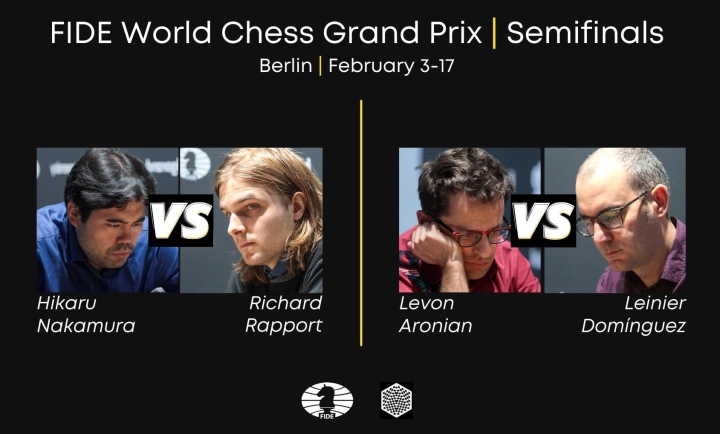
IM Michael Rahal – Berlin, February 11th 2022 –”That’s what chess is. You train so hard, and then everything depends on that crucial few seconds of decision making.” Wesley So’s final reflection after losing his semifinal sums up very well the extreme difficulty of being elite chess professional. Rapid and blitz game tiebreaks are the real test for today’s modern chess player. Calculation skills become slightly less important, and as the time on the clock starts to run low, pure intuition comes to the fore. Good nerves, decent physical condition, stamina, and a well-thought-out opening repertoire are some of the key skills that have to be honed at home before the competition to be a good tiebreaker. Superior players excel even more with reduced time, thanks to better intuition and pattern knowledge plus match experience and today’s tiebreakers were no exception. After the preliminary qualifying stage finished, two pools still had to determine the winners. The rules and regulations of the 2022 FIDE Grand Prix read that tiebreaks are used to determine who advances to the semifinals: two rapid games – 15 minutes base time + 10 seconds increment – followed by two blitz 3/2 games. A nerve-racking “Armageddon” decisive game is left for the end: 5 minutes vs 4 on the clock, and Black advances in case of a draw. Tiebreak 1: GM Radoslaw Wojtaszek (Poland 2702) – GM Richard Rapport Hungary (2779) According to the database, Wojtaszek and Rapport have faced each other twelve times during their careers, with a total head-to-head score of 7-5. However, the trend in the tournament seemed to favour Rapport: he qualified for the tiebreaks in the last minute by defeating Fedoseev yesterday, while Wojtaszek missed a huge opportunity for direct qualification to the semifinals. In the first game Rapport opted for the double-edged King’s Indian Defence with Black, his main weapon for most of his career. Wojtaszek had prepared a very solid fianchetto variation which has also served him well for many years. The game proved to be very exciting and remained balanced until the opponents reached a double-rook ending. Rapport retained a strong passed pawn which eventually advanced to the seventh rank: it’s a well-known fact that these endgames with two rooks and passed pawns are extremely tricky. With precise play, the game should have been a draw, but, very low on time, Wojtaszek chose the wrong defence, and his king fell into a mating net. Having won the first game, Rapport played it safe in the second. Faced with Wojtaszek’s Sicilian defence, he chose the solid 3.Bb5+, and went on to exchange every piece in sight. Even though he ended up a pawn down in a bishop ending, the Hungarian was never in any danger and drew the game effortlessly, securing his spot in the semifinals, where he will face-off against Hikaru Nakamura. After the match, both players talked to IM Michael Rahal, Press Officer for the event. “I was just lucky even to have qualified for the tiebreak,” said Rapport. “In today’s first game, I got a decent position from the opening. Objectively it should be equal, but both of us were trying to create some imbalances. The resulting rook ending should be fine, but it’s somewhat uncomfortable for White because he has to watch out for checks all the time. In the end, he was low on time and blundered the mate.” When questioned about tomorrow’s semifinal against Nakamura, Rapport dodged the issue: “I am really tired after this tiebreak and yesterday I also had a must-win game, so it takes a toll. But I guess there is no rest for the wicked, so I have to keep on going.” When questioned about his opening choice in the second game, Wojtaszek took it in his stride and jokingly said that “Maybe I should have chosen something different because Rapport probably checked this line in his room during the break! The ending is just a draw, and there are hardly any real chances to do something different. I wasn’t expecting to lose the first game with White, so I wasn’t really ready for this scenario”. Tiebreak 2: GM Wesley So (USA 2782) – GM Leinier Dominguez (USA 2722) According to the database, So and Dominguez have faced each other on 53 occasions, most of them in rapid and blitz events, with a total score of 29-24 for Wesley So, making him a very slight favourite in this two-game match-up. The first game was apparently a dull affair. With White, Wesley avoided the main theoretical lines in the solid Queen’s Gambit Accepted and went for a queenless ending that theory considers completely equal. However, World Chess online commentator Evgenij Miroshnichenko observed: “This kind of setup is, in fact, dangerous for Black, especially if he does not realize the dangers.” But once again, Leinier’s defensive skills were on point, and after precise play, a draw was agreed on move forty-two, a very good result for Dominguez. The second game was clearly the most exciting of the afternoon. Once again, Leinier went for the Italian Opening, and soon the game was in unknown territory. Wesley opted for a defensive plan with several pawn moves (d6-c6-f6), which he recognized after the game was possibly not the best choice. After a few inaccuracies and facing the unattractive possibility of losing a central pawn, So sacrificed his knight on g2. With under a minute left on his clock, Dominguez found an excellent counter-attack and threatened mate with 30.Qd3. So parried the threat and created his own attack on Dominguez’s king, but the native of Cuba found the only move 32.Kh1 (any other move would lose the game), and Wesley was forced to resign. Asked about his performance in the first game, Wesley gave an honest opinion: “Accidents happen; this tiebreak was very short. I knew it was a 50/50 chance; Leinier is very dangerous in the opening, so I decided to play whatever to avoid getting too tired. I have already played this line against Lenier two or
FIDE – ISF World School Online Cup: Registration continues
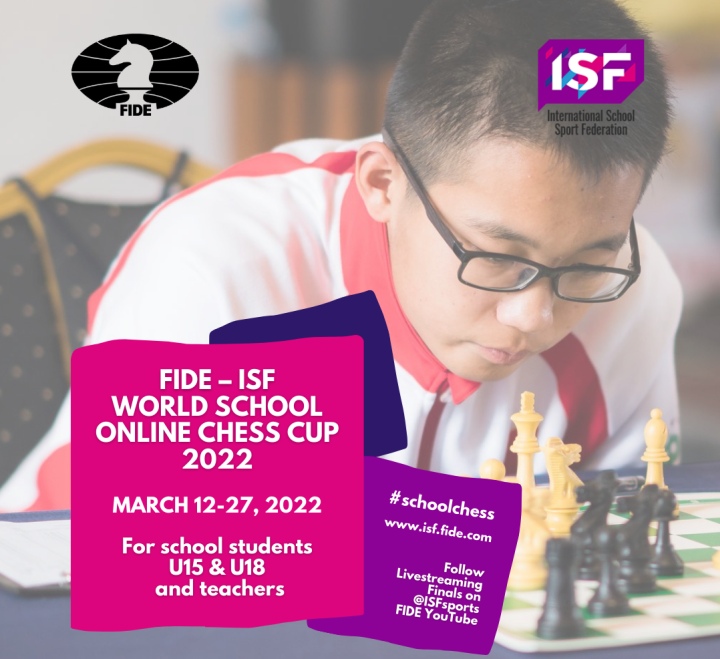
The FIDE – ISF World School Championship Online Chess Cup 2022, organised by FIDE and the International School Sport Federation (ISF), will be held online on Tornelo platform from March 12-27, 2022. The event, which aims to motivate young students and teachers to actively participate in the online chess competitions, includes tournaments among teachers and students in the boys and girls U15 and U18 age categories. The qualification tournaments for students are scheduled for March 12 and 13, while the finals will take place on March 19 and 20. The teachers’ event will be held on March 26 (qualification tournaments) and March 27 (finals). The finals will be live-streamed on the YouTube channels of both FIDE and ISF. Time control of the event is 3 minutes + 2 seconds increment per move. The qualification tournaments will be played in a Swiss System format of 11 rounds. The top 40 players in the final ranking in the qualification tournament will advance to the finals in each category. The finals will be 9-round Swiss tournaments. Participating in the tournaments offers a unique opportunity to visit the World Chess Olympiad 2022. The winners in each category will be awarded the tickets to Moscow with free two-night accommodation in the official hotel of the Olympiad. All the medal-winners will also receive free lessons with top grandmasters. The participation fee is 30€ per participant. Since the start of registration, participants from Australia, Bolivia, Canada, China, India, Indonesia, Malaysia, Nigeria, Pakistan, Poland, Qatar, Thailand, Turkey, Uganda, and Vietnam have already applied for the event. Students and teachers from all around the world are invited to join us for the first-ever FIDE – ISF World School Online Chess Cup this March! The tournament registration continues through March 05, 2022 (for students) and March 12, 2022 (for teachers). To register, visit the ISF website. For more information, please, visit the official website of the FIDE – ISF World School Championship Online Chess Cup 2022. About International School Sport Federation (ISF) Based in Brussels Belgium, the International School Sport Federation is an international multi-sport organisation, recognised by the International Olympic Committee (IOC) since 1995 gathering 132 National School Sport Organisations all around the world. Together with their members, ISF organises more than 10 international sport competitions and grassroots sport and educational events every year for school students aged between 6 to 18 years. With more than 40 sports in its programmes with established partnerships with the relevant International Federations, the ISF organises four different categories of events: Multisport Games U18 – U15; World Schools Championships, School Sport Cups and Educational events. In September 2021, FIDE and ISF signed a memorandum of understanding, ensuring the development and promotion of chess through school sport. The document signed within the framework of the School Sport Forum held in Belgrade, Serbia, encourages and supports the education of youth through chess sport and culture, contributing to the social and intellectual development of youth, and promotes the sport of chess and its role in education at a local and international level.
FIDE distributes €30,000 among distinguished veterans
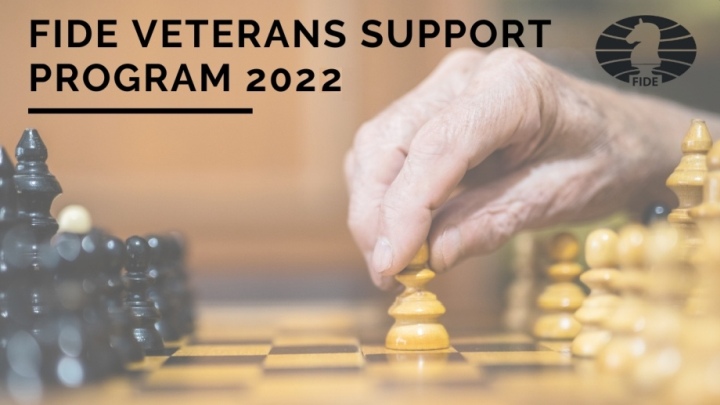
After carefully considering the numerous applications received, the special panel appointed by the FIDE Council decided that these will be the twelve chess players, coaches, and promoters to benefit from FIDE’s support to chess veterans in 2022: Alexey Yuneev (Russia) Jay Bonin (USA) Jiri Lechtynsky (Czech Republic) Vija Rozlapa (Latvia) Giorgi Macharashvili (Georgia) Reynaldo Vera (Cuba) Evgenij Ermenkov (Bulgaria) Alexey Kosikov (Ukraine) Sheila Jackson (England) Galina Strutinskaia (Russia) Rani Hamid (Bangladesh) Gediminas Rastenis (Lithuania) A total of €30,000 will be distributed among these seniors with each person from the list receiving €2,500. Depending on Covid-19 restrictions, FIDE will either increase a prize fund in veteran championships this year or allocate a similar amount for the second instalment to our distinguished seniors.
FIDE Grand Prix: Nakamura joins Aronian in semifinals
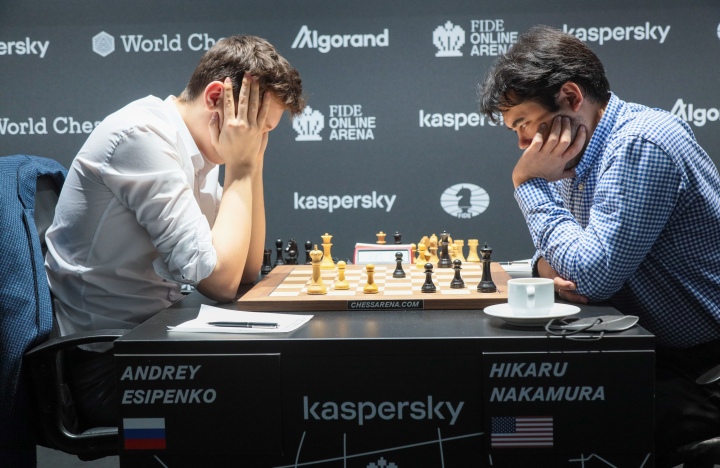
So-Dominguez and Rapport-Wojtaszek to battle in out in the playoffs IM Michael Rahal – Berlin, February 10th 2022 – The final round of the qualifying stage was without any doubt the most exciting chess witnessed in Berlin during the last few days. With a lot at stake, all the games (with the exception of Aronian – Dubov) were fought to the bitter end. The ceremonial first move was executed by Richard Lutz, CEO of Deutsche Bahn (German Railways). Mr. Lutz is a strong player himself, and Deutsche Bahn has been a regular supporter of chess in Germany over the years. He opened the game for Vidit with 1.c4 against local player Vincent Keymer, and the games were on! Pool A In a must-win scenario, Andrey Esipenko opened with 1.e4 against Hikaru Nakamura. A draw would be enough for the American, so he went back to the solid 1…e5, his main option for the last few years. Esipenko chose the Italian Opening, and both players more or less blitzed out their opening moves, following a previous 2019 game between Alekseenko and Grischuk. The Russian could have won a pawn with 14.Bxa6 – a move he considered for nearly 15 minutes – but instead, he preferred to advance in the center. With 16.d5, he closed the position and went for a structure resembling the King’s Indian defence: for that reason, as soon as he got the chance, Nakamura lashed out with the typical counter 21…f5. Esipenko took over the initiative and firmly wedged his pawn to e6, achieving a decisive advantage. But in the time scramble, he missed several winning opportunities, allowing Nakamura to escape unscathed into a slightly worse queen ending which he was able to hold to a draw. In his postgame interview with FIDE Press Officer IM Michael Rahal, a visibly relieved Hikaru Nakamura gave his take on the game: “In the opening I got very creative, mixing up a bunch of plans. I thought I was worse, and Andrey played very well. Just when I thought I was fine I blundered with Kh7, and I was close to resigning”. Although all eyes were on the Esipenko-Nakamura game, next to them, Alexander Grischuk and Etienne Bacrot were fighting it out to avoid last place. Bacrot left his French defence at home and brought out the classical variation of the Sicilian defence. Possibly suspecting this, Grischuk followed the 2021 game between Anish Giri and Maxime Vachier-Lagrave (MVL is coached by Bacrot) but Etienne deviated with the novelty 15…Qc5, offering the exchange of queens, which Grischuk declined. The online commentators were slightly worried that Bacrot was risking too much by leaving his king in the center of the board, with so many heavy pieces surrounding it, but this is the well-known strategy in the variation. The Frenchman missed a huge winning opportunity on move twenty: facing an attack on his queen, Bacrot instantly moved it away with 20…Qb6. However, the unbelievable tactic 20…Nxe4! would have led to a winning position, in view of 21.Nxe4 Bxe4! 22.Rxc5 dxc5 23.Qe1 Rxd1 24.Qxd1 Rxh2 followed by 25…Rh1 winning. As soon as this idea was voiced in the postgame conference, Alexander immediately saw the whole line in his head. Grischuk didn’t allow a second chance and struck back with a classic Sicilian knight sacrifice on d5, opening the game for his pieces and achieving a winning attack. Although he missed some opportunities to finish the game – among other things because Bacrot was huge in defence – in the end, he got the job done. Pool B In the first game, Grigoriy Oparin chose an enterprising but risky variation of the Reti opening, winning a pawn but falling behind heavily in development. Radoslaw Wojtaszek took up the gauntlet and began to centralize his pieces – a win would give him excellent chances to take clear first. The precise 18….Nd3+ installed a strong pawn on d3 and was the prelude to a kingside offensive. In addition to his precarious position, Oparin was dangerously falling behind on the clock. When everything seemed to be on point for Poland’s number two, a couple of inaccurate moves allowed Oparin to exchange queens and with a daring exchange sacrifice, he took over the imitative and forced a three-fold move repetition draw. In the postgame interview, Radek lamented his missed opportunities: “I was sure that I was winning at some moment, but I had to play the correct moves, and I failed”. Asked about improvement ideas for his participation in the third leg, Oparin was very clear: “I have played so badly here that I have many things to improve, tactics, openings, and recover my best form”. Meanwhile, with Black against Vladimir Fedoseev, Richard Rapport was doing his best to unbalance the position. His opening choice was already a sign of intent: the offbeat Chigorin defence. Fedoseev played it safe with the solid 3.Bf4 line and again, Rapport chose to unbalance the pawn structure by recapturing 6…cxd6, doubling a pawn, but avoiding symmetry at all cost. However, Fedoseev kept his calm, opened the position and initiated exchanges on the c-file. It seemed that the Russian missed a good chance to achieve an advantage on move twenty-two: instead of 22.Re1, the computer was blasting out 22.e4! The position remained balanced, and Fedoseev did have a chance to claim a three-fold move repetition which he declined. Possibly not the best decision as after the queen exchange, Rapport took over and, with excellent endgame technique, outplayed his opponent. In an incredible turn of events, Richard Rapport will now face Radoslaw Wojtaszek for a place in the semifinals. The winner of tomorrow’s playoffs will play against Hikaru Nakamura. Pool C The first game to finish was a quick draw between Levon Aronian and Daniil Dubov. Although hardly fifteen minutes went by from the beginning of the round, Aronian had an explanation ready: “I wasn’t expecting this line, so when Daniil played 8…Nbd7, I remembered my analysis, which was a long and very sharp line”. Aronian
Media warm-up for FIDE Grand Prix held in Belgrade
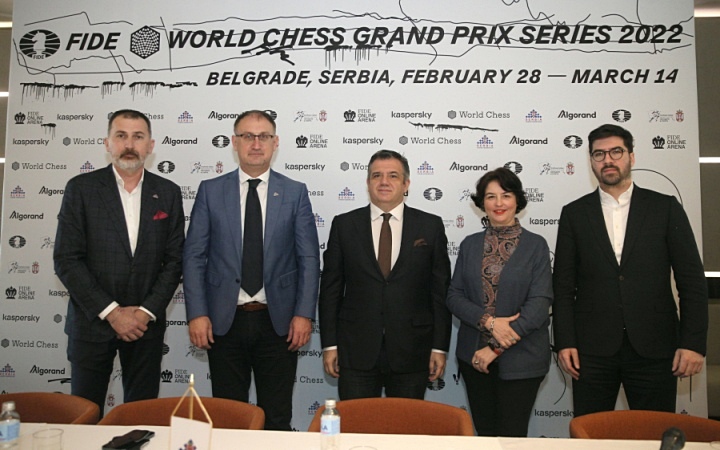
Scores of reporters and media crews show up for the media ‘warm-up’ event, showing how eagerly the tournament is anticipated in Serbia. Ahead of the second leg of the World Chess Grand Prix, which will take place in Belgrade (Serbia) between the 28th February and 14th March, the Chess Federation of Serbia organised a ‘warm-up’ event for the media. A significant number of journalists from Serbia and the region who turned up reminded how important and popular the 64-square game is in this once great chess country. The media event started with a short video depicting the historic chess tournaments and figures who visited, played or were born in Yugoslavia. Previously the capital of the mighty chess nation, it has been decades since the region has been home to a major chess event involving many of the world’s strongest players. The anticipation of the Grand Prix tournament has already attracted a lot of public interest, and the Serbian government has pledged its support for the event. Speaking at the media conference in Belgrade’s Crowne Plaza Hotel (where the tournament will be played), Alisa Maric – once one of the strongest world female Grandmasters – said that she is very happy as, after many decades, Serbia will once again play host to the chess elite. “This tournament is taking us back to the old times when the best players from all over the world came and played here. I hope that this is just the beginning and that this event will also serve as motivation to our own young players to strive forward and flourish.” The President of the Chess Federation of Serbia, Dragan Lazic, expressed his gratitude to FIDE for entrusting Belgrade to host one of the Grand Prix events: “Serbia has not hosted such a big event since the 1990s. I believe that this is just the first step towards achieving our ambition – for Serbia to be the host of a Chess Olympiad.” Lazic added that the organisers would do everything to ensure that the players enjoy their time here, have excellent playing conditions and feel safe and comfortable. Support for the event is also provided by the Serbian government. Belgrade deputy mayor, Goran Vesic, stressed the importance of the event for Serbia – its image, chess tradition and culture. Vesic said that the government would consider how to further increase and improve chess programs in schools and make them part of the curriculum. The 2022 FIDE Grand Prix, a part of the world championship cycle, consists of three tournaments. The tournaments take place in Berlin (Germany) and Belgrade (Serbia) between February and April 2022. The two top performing players in the Grand Prix will qualify for the 2022 Candidates Tournament in Madrid (June-July). Text: Milan Dinic Photo: Marko Metlas/Alo!
FIDE Grand Prix: Levon Aronian, first semifinalist
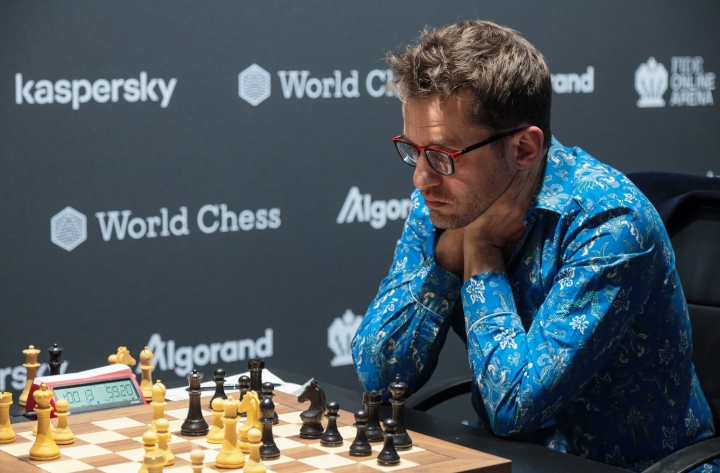
The last round will decide the other three spots. IM Michael Rahal – Berlin, February 9th 2022 – Today’s round in the Berlin Grand Prix began with a bit of drama. The President of the German Chess Federation, Ullrich Krause, had been invited to execute the first “ceremonial” move on GM Vincent Keymer’s board. However, while fifteen of the sixteen players were already firmly seated, most of them fully concentrated, Keymer’s opponent – GM Levon Aronian – had yet to appear. The signs of relief on Chief Arbiter Ivan Syrovy’s face when Aronian finally stepped into the playing venue at exactly 14.59 were clearly visible. The former Armenian player, now representing the USA, greeted his opponent and awaited 1.d4, in this case, played by Krause, and the round was on. And an exciting round it was! Four wins and four draws in an eight-player round-robin is a remarkable statistic. In addition, Aronian’s win over Keymer qualifies the USA competitor to the semifinals, while Esipenko and Dominguez scored important wins with Black that allow them to keep their qualifying chances intact for tomorrow’s final round. Pool A Trailing Hikaru Nakamura by half a point, but playing Black, Alexander Grischuk had a really difficult task ahead of him. His opening choice, the double-edged King’s Indian Defence, definitely seems the way to go to fight for a win. However, after Nakamura’s 6.Be3 – the Semi-Averbakh variation, a fitting choice as the legendary Russian Grand Master turned 100 yesterday – Grischuk plunged into deep 15-minute thought. He finally decided to follow the main line but around move twenty, he was already down to his last twenty minutes, a startling contrast to Nakamura’s one hour twenty. At the critical moment, Nakamura transferred his bishop to b2, zeroing in on Grischuk’s king, already weakened on the dark squares thanks to an early h-pawn push by the American. With hardly any thinking time and facing a direct attack, the Russian buckled under the pressure – his position crumbled, leaving Grischuk out of the race for qualification. Asked by Press Officer Michael Rahal what could he take away from the game, his reply, as usual, wasn’t disappointing: “I probably have to stop playing the King’s Indian”, finding some light humour in a desperate tournament moment. In the other game of the A-pool, Andrey Esipenko had no other chance but to shoot his last bolt to defeat the last-placed competitor of the group, Etienne Bacrot. He was probably going to play the Marshall Attack, but Bacrot nipped that idea in the bud, deciding on a solid anti-Marshall line with a rapid exchange of queens. The game remained mainly balanced until Bacrot played 27.Bc4. Esipenko grabbed the chance to plant his rook on d4 and began to advance his kingside pawns, eventually creating a passed g-pawn that ultimately decided the game in his favour. In his postgame interview, Bacrot said that he had been quite lazy in his calculations and should never have fallen into this passive endgame position. Esipenko was obviously very happy with the outcome and will now have White against Nakamura in the last round: whoever wins will qualify to the semifinals, but Nakamura also advances with a draw. Pool B The first game of the afternoon to finish was a quick affair. Playing with White against the co-leader of the group, Radoslaw Wojtaszek decided to play it safe. Slightly surprised by his opponent’s opening choice, Radek recognized in the postgame interview that he had missed 18…Rc4 and that he even thought that he was slightly worse, given which he decided to initiate mass exchanges leading to a three-fold repetition in a completely level position. Although Vladimir Fedoseev still has to face (with White) Rapport in the last round, his solid opening choice clearly indicates that a draw was a good result for him today. Meanwhile, in the other game, Grigoriy Oparin repeated the Tarrasch variation he already played in the third round. When the pawn structure stabilized, he found himself with another isolated d-pawn position which he seems to enjoy defending: a weak pawn but in exchange for active piece play. However, when things seemed to be going well for Richard Rapport, he missed 23…Ng3 and had to take on the defensive. Oparin started piling on the pressure and gradually increased his advantage in the endgame. On move 41, just after the time control, Oparin missed a great opportunity to win on the spot with 41…Re2+ before capturing the pawn on f2. In the postmortem on the board, both players thought that it was a draw, but further analysis seemed to confirm the win for Black. These results leave everything open for the last round: a very exciting and interesting tournament situation where the winner of the game between Fedoseev and Rapport could easily win a spot in the tiebreaks. Pool C Possibly inspired by the President of the German Chess Federation’s first move, Vincent Keymer went all-out for Aronian’s throat in today’s game. Trailing the leader by two points but playing with the white pieces, Keymer went for a crazy pawn-grab in the solid Ragozin Defence (13.Nxe5 instead of the prudent 13.0-0), allowing his opponent to force his king into the center with hardly any protection. An unrelenting battle began, with players attacking with heavy shots such as 17.g4, 17…g5 and 18.b4. Computer analysis indeed confirmed that the players were finding the best moves, but White’s position seemed to be always hanging by a thread. Things remained tactically balanced until Keymer blundered big with 29.Rh5? (29.f3 was still equal according to the computer). Aronian seized the moment, capturing the two center pawns, and the game was over. In the postgame interview, both players mentioned that they had analyzed the position after 13.Nxe5 some time back, but it was hard to remember the various lines. In the other game of the group, both Vidit Gujrathi and Daniil Dubov, tied on two points out of four, faced their last opportunity to win a full point and catch Aronian. A Tarrasch defence transposed into a sideline of the Queen’s Gambit Accepted. Although Dubov declared that he had spent the
#38
A podcast, many workshops, and more #womeninchess World Championship Match 2023: call for bids FIDE and ISF launch the World School Online Chess Cup The chess world celebrates the centenary of Yuri Averbakh “Chess for Freedom” keeps making waves READ NEWSLETTER

